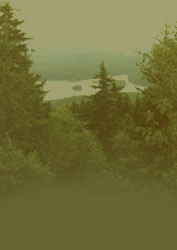|
Do you have something
happening in your corner of Washington? - Please call a member
or e-mail your observations to have them included here
December:
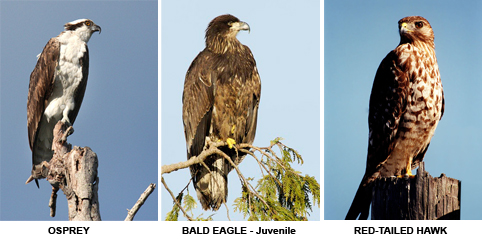
Osprey photo charlie's
Bird Blog
Bald Eagle photo Wise
Nature Photos
Red-Tailed Hawk photo Wikimedia
Arin saw a large bird recently near the "Park and Ride" in
Hillsboro. She wondered whether it was an Osprey or a Red-Tailed
Hawk and Carol suggested it could be a juvenile Bald Eagle.
We wondered what they all looked like and whether any of these
birds would still be around this time of year.
Osprey are found statewide but are scarce
in southwestern NH. They have a 4.5' to 6' wingspan and adults
weigh 2.5 to 4 lbs. Osprey have a white breast and white belly
with a dark brown back and wings. Osprey heads are white with
a dark eye mask that runs from their black beak to the back
of their head and down the nape of their neck. Osprey eyes
are yellow and legs and feet are gray. They are commonly confused
with the juvenile Bald Eagle.
Their large nests are built out of sticks on dead trees and
on man-made structures like utility poles, platforms, and
bridges. Breeding occurs within 1-2 miles of rivers, lakes,
estuaries and other bodies of water containing fish. They
winter in the Caribbean and tropical portions of South America.
Osprey arrive in NH during April to breed and raise their
young. They eat almost entirely fish which they catch by diving
feet-first into the water at speeds up to 80 mph.
The Bald Eagle is 3' tall with a 6-8' wing
span and females weigh up to 14 lbs; males weighing 7-10 lbs.
Immature bald eagles are mottled light brown, tan, and white
until age 3 or 4. They have brown eyes, a black beak, and
yellow feet. Adult bald eagles have a distinctive white head
and white tail feathers, and a dark brown body and wings.
Their eyes are pale yellow and the powerful beak and unfeathered
feet are bright yellow. Immature bald eagles can be confused
with golden eagles or osprey.
Bald eagles breed in forested areas near bodies of water and
winter near open water (i.e. coastal areas, rivers, and lakes
with open water). They build large nests in tall trees near
the water’s edge.
Females lay 1-3 eggs in the spring. Both the male and female
incubate the eggs and young hatch after five weeks. Bald eagles
often retain the same mate for many years and reuse the same
nest from year to year. Bald eagles primarily eat fish, but
will also supplement their diet with a wide variety of small
animals and with carrion.
The Red-tailed Hawk is 18-25 inches in length
with a wingspan of 4 feet and it weighs 2 to 4 pounds. It
is dark brown to gray brown on its back and on the top of
its wings. It has light brown or cream undersides and a cinnamon
colored neck and chest. It has a dark band across its belly
and a broad, round, rusty red tail. The red-tailed hawk breeds
in most parts of the United States and Canada south to Mexico
and Central America. Birds in the northern most part of its
range may migrate south in the winter.
The red-tailed hawk lives in deciduous forests and open areas
like swamps, deserts, tundra, plains and agricultural lands.
It prefers places with high perches that is can use to search
for food. It can often be seen sitting on telephone poles
and wires looking for prey!
The red-tailed hawk soars over open land searching for prey
like small rodents. Its has excellent eyesight and can see
the slightest movement in the grass below. It uses its sharp
talons to kill its prey and may also hunt fish and reptiles.
So, it seems that it really could have been the juvenile Bald
Eagle because the other two leave for the winter, but we had
such a long, warm fall they may not have left yet for their
warmer winter home.
Information about the Osprey
was found here: NH Fish and Game
Information about the Bald Eagle
was found here: NH Fish and Game
Information about the Osprey
was found here: NHPTV Nature Works
November:
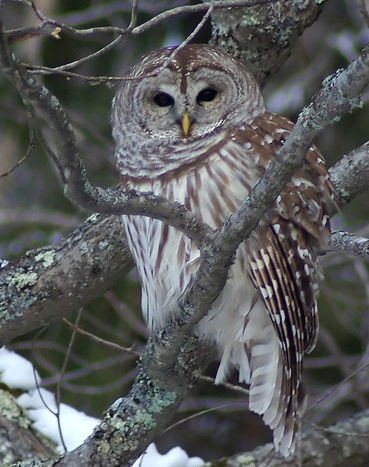
Owl photo from flicker
Jed spotted an owl recently and found out that it was a
Barred Owl.
New Hampshire's woods and swamps are home to several species
of owls. Four owl species regularly nest here: great horned,
barred, Eastern screech and Northern saw-whet.
Our most common and widespread owl is the barred owl. Their
"who cooks for you, who cooks for you all" calls are probably
familiar to most. The barred is a little smaller than the
great horned and is a uniform gray color with darker barring
on its upper chest and streaks on the belly. The barred owl
lacks ear tufts and its eyes are dark brown.
The barred owl is found throughout the state, although it
is less common in the far north. In New Hampshire it is primarily
a cavity nester, finding the rotted-out trunk of an old maple
tree ideal. The barred does not nest quite as early as the
great horned owl, but certainly by March is well into its
breeding cycle. That's when the barred owl is at its noisiest.
Night after night, you can hear its monkey-like laughing as
it squares off with rivals and courts in the forest. Barred
owls often nest near maple and beaver swamps. The wetlands
provide a rich diversity of prey, which includes many amphibians
in the spring and summer months.
Winter is when owls nest, so it is a great time of year to
go owl watching. On a full moon night, go out to a nearby
woods and listen. The pairs will call back and forth, and
if you can learn to imitate their calls, they might just answer
you! Once you hear an owl, move quietly nearer. Some people
like to bring a flashlight to shine on the owl, but first
get your eyes accustomed to the dark so you will see their
shape perched in a tree. Then use the light - but only for
a moment; those owls have nests to care for!.
Information about the Barred
Owl was found here: New
Hampshire Fish and Game, Wildlife Journal
October:
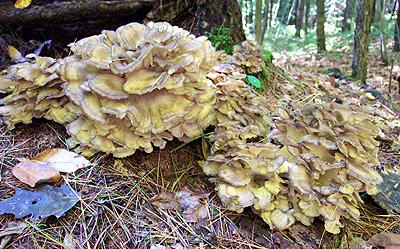
Mushroom photo from The
Forager Press
Carol just found a large (13 1/2 lbs!) "Hen of the
Woods" mushroom, also know as Miatake (in Japan)
or Sheepshead mushroom.
Grifola frondosa fruits anytime from early September to late
October and seems to be triggered by the first cold nights
of the end of summer. It is found mostly with dead or dying
Oak trees, though sometimes you can find clusters under a
dead Maple. Once you find one, go back the next year and you
may find it again.
They vary widely in color, from pure white to tan to brown
to gray. It appears to get darker depending on how much direct
sunlight they receive. Large overlapping leaf-like fronds
grow in bushy clusters that get larger with time. It resembles
a mother hen sitting on her nest in the woods. Each frond
is from a half to four inches across and is usually darker
to the outward edges of the "caps." The entire fruiting body
can be as big as several feet across. The underside of individual
caps consists of a pure white pore surface. Grifola frondosa
is a polypore, a mushroom which disperses its spores from
pores as opposed to gills. The pores are close together and
tiny, almost difficult to see. The caps are firm and juicy
and the stem is thick firm, white and branched.
They are known for having fabulous flavor and a firm texture
that lends itself to almost any culinary application. They
are easy to store, just chop up into what ever size pieces
you like to cook with and store them in freezer bags in the
freezer without any par-boiling. It's good for you, rich in
minerals and vitamins, and studies are beginning to reveal
immune-enhancing and cancer-preventing properties of this
mushroom.
As with any wild mushroom, know what you are eating! This
mushroom has been known to cause an allergic reaction in some
people.
Information about the Hen of
the Woods mushroom was found here: The
Forager Press
September:
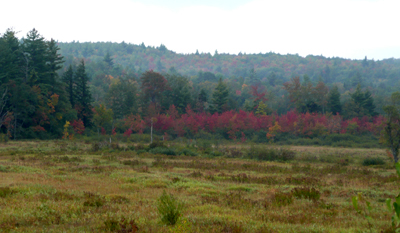
Swamp Maple photo from Jed Schwartz
The earliest bits of beautiful color we see in the fall are
the Swamp Maples.
Red maple forested wetlands, better known as red maple swamps,
are the most abundant freshwater wetland type in New Hampshire
and throughout the northeast. Red maple swamps can occur on
river terraces, in oxbows, behind natural levees, and on the
low-lying inner floodplain of rivers. They can also be found
in undrained basins. Such swamps exhibit the characteristic
mound-and-pool topography, where trees and shrubs are rooted
primarily in mounds. Red maple swamps can also occur on slopes
or in shallow depressions along intermittent or upper perennial
streams.
Red maple is a moderately flood-tolerant tree that is most
common on sites that are intermediate in wetness between permanent
flooding and temporary or intermittent flooding. The red maples
ability to persist under these adverse conditions when compared
with other wetland tree species, lies in its ability to produce
a heavy seed crop nearly every spring, its rapid seed germination,
and its ability to vigorously sprout from stumps and damaged
seedlings on a variety of disturbed sites.
Water levels in red maple swamps are highly dynamic. They
typically vary between seasons, years, and individual swamps.
In New Hampshire, red maple swamp water levels are normally
highest during the winter and spring, and lowest during late
summer or early fall. The distribution of plant species in
a swamp is influenced by how long the soil remains saturated.
Red maple's predominate in swamps where soils are saturated
or flooded from late fall through early summer in most years.
The seasonal flooding of red maple swamps provides the standing
water that many amphibians require for breeding, and provides
feeding and resting areas for migrating waterfowl. Swamps
containing streams tend to support a higher number of species
of reptiles and amphibians than forests lacking streams. The
two most important aspects of the red maple swamp plant community
are structure (i.e. vegetation height, density, percent cover,
number of developed vegetation layers, etc.) and floristic
composition. Red maple swamps may contain as many as five
separate and extremely vital vegetation layers.
These layers include:
• Trees
• Samples
• Shrubs
• Herbs (ferns, wildflowers, grasses)
• Ground cover (mosses, lichens)
In the northeast, the flora of red maple swamps is rich and
diverse, including at least 50 species of trees, more than
90 species of shrubs and vines, and more than 300 species
of nonwoody plants. However, a few species usually predominate
at any one site. In New Hampshire, there are several species
of plants that are found in red maple swamps that are state
listed as either critically endangered, endangered, or threatened.
Such plants include Yellow and Showy Lady's Slippers, Great
Rhododendron, and Swamp Azalea.
In New Hampshire, red maple swamps are home to such rare species
as the marbled salamander. They are the principal forest type
used by breeding wood ducks in the northeast. Songbirds (e.g.,
Canada warbler, veery) and birds of prey (e.g., red-shouldered
hawk, barred owl) have an affinity for red maple swamps. Nearly
50 species of mammals live in red maple swamps, including
black bears, white-tailed deer, moose, and bats.
In addition to providing habitat to wetland dependent and
upland wildlife, red maple swamps perform many functions that
bear directly on public safety, health, and welfare. Their
ability to reduce the peak level of floods and to delay the
flood crest is widely recognized. By collecting precipitation
and overland flow and recharging the underlying groundwater
system, swamps may augment domestic and municipal water supplies.
Forested wetlands improve surface water quality by retaining,
removing, or transforming pollutants that enter the wetland
through stormwater and wastewater discharges.
Red maple swamps are valuable for their use as recreation
and open space areas, and their scenic beauty. They are frequented
by hunters, wildlife photographers, and birdwatchers.
What would New Hampshire be like without the brilliant yellow,
red, and orange foliage of red maples in the fall?
Information about swamp maples
was found here: NH
DES factsheets - Swamp Maples
August:
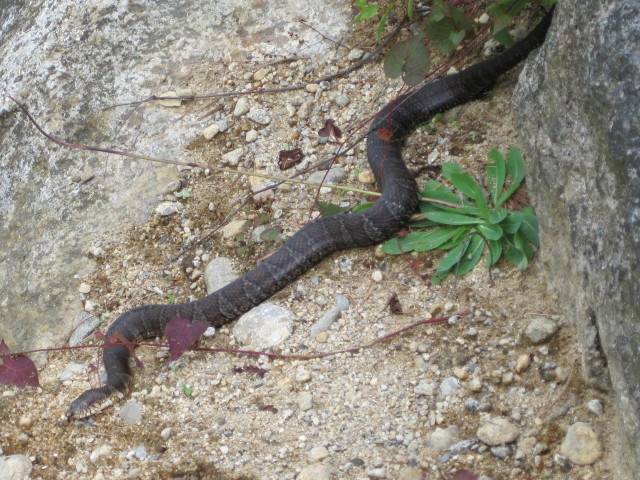
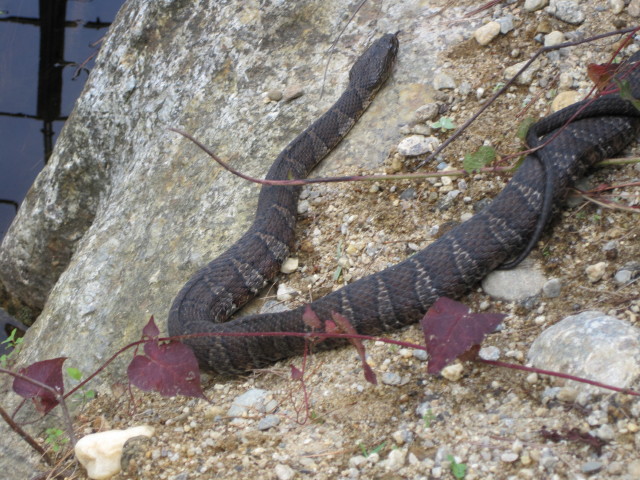
Snake photos from Ed Thayer
Ed Thayer sent us some great wildlife shots from locations
around town (and nearby). He spotted this Northern
Water Snake laying on the head wall of the culvert
header on Carol's property in Bradford by the beaver deciever
(more info on the beaver deceiver here: New
in Nature 2008 - November). The Northern Water Snake
can be 24-42 inches long and is found widely in New Hampshire.
It can be confused with the Milk Snake or Timber Rattlesnake
and is almost always found near water.
For more information about the water snake go here: NH
Fish and Game, Northern Water Snakes
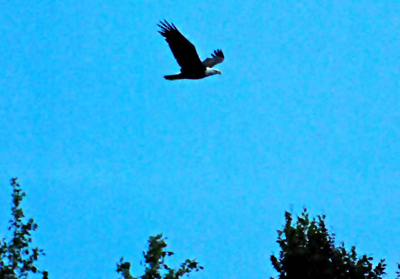
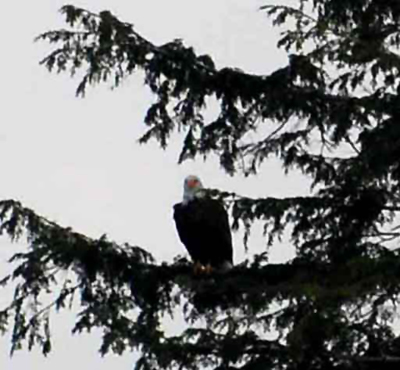
Eagle photos by Janice Philbrick
Janice Philbrick had her camera with her in the right place
at the right time and caught this magnificent Bald
Eagle near Island Pond. If you see an eagle NH Fish
and Game wants to know! For more information about the Bald
Eagle in New Hampshire go here: NH
Fish and Game, Bald Eagles
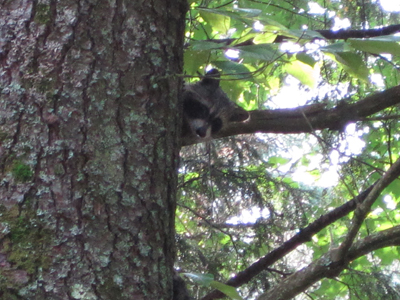
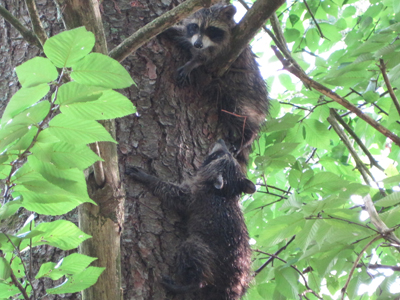
Racoon photos from Ed Thayer
These baby raccoons are a very cute little
pair. While not an unusual sight, raccoons are found all over
town, it isn't too often that you see two youngsters playing
together.
Another cute baby was spotted by Reid Schwartz who shared
the next two photos. This little porcupine
stayed in the apple tree munching on twigs and apples for
several days.
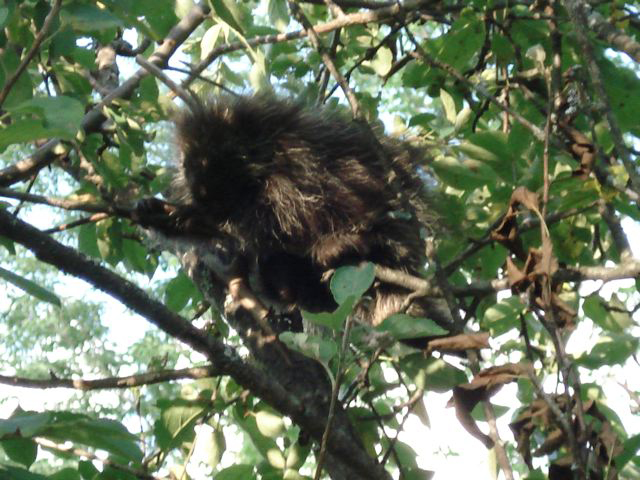
Suddenly one day, Mama (shown below) appeared and collected
her young one and they moved on.
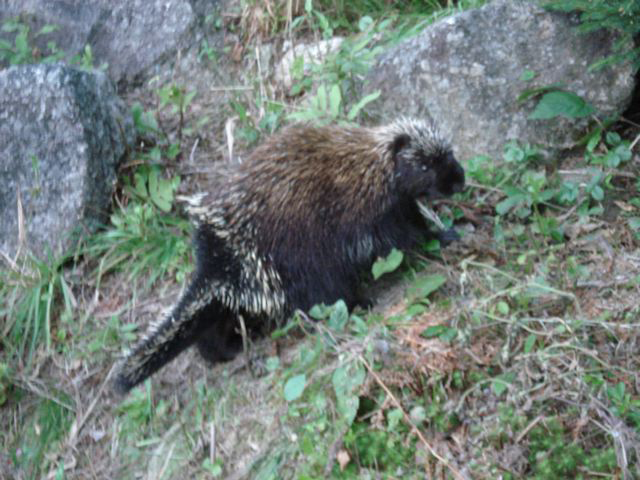
Remember not to pick up young animals that you find in the
wild, they are rarely orphans and Mama is probably somewhere
nearby. Enjoy them from a little distance and take all the
pictures you want. For more tips on what to do (and what not
to do) when you find baby animals go here: NH
Fish and Game, Keep Wildlife Wild
July:
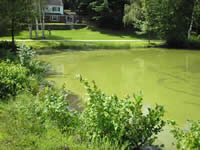 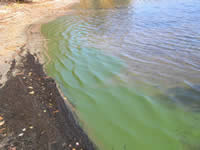
Photos from NHDES
Arin wondered if any of our local lakes have been tested for
cyanobacteria or have any bacteria blooms shown up.
We decided we better find out about cyanobacteria.
Cyanobacteria blooms are aesthetically displeasing in sight,
odor, and taste, as well as potentially toxic to domestic
animals, livestock, waterfowl, and humans. Many cyanobacteria
produce toxins (collectively referred to as "cyanotoxins")
that may be released into the water when cells die or consumed
by organisms in the food chain. There are four common cyanobacteria
to New Hampshire's lakes and ponds that produce toxins. These
toxins may be hepatotoxins (liver and kidney), neurotoxins
(central nervous system) or dermatotoxins (skin irritants)
capable of causing both acute and chronic illnesses. Acute
effects, such as skin and mucous membrane irritations, can
occur after short term exposure with water containing these
toxins. Chronic effects, such as liver, kidney, and central
nervous system damage, can occur over a period of time from
ingestion of water containing large amounts of toxins.
The state's Beach Program takes a proactive
approach when cyanobacteria blooms or scums appear at public
beaches. A beach advisory sign is posted when a potentially
toxic cyanobacteria species is present and identified as the
dominant algae in the cell count. You can check for advisories
here: NH
Beaches
You can help keep the cyanobacteria from forming in the first
place. Research indicates that their numbers increase as the
nutrients in the water increase. To reduce the chances of
a bloom occurring, reduce the amount of nutrients, such as
phosphates, that enter the water. Homeowners can help by testing
their soils before applying fertilizers and, if they must
apply a fertilizer, making sure that they apply only what
they need. The NH Shoreland Protection Act prohibits the use
of fertilizer closer than 25 feet from shore. Also, between
25 and 250 feet from shore, only low phosphate, slow release
nitrogen fertilizer may be used. Keeping your septic system
maintained will also help keep nutrients from leaching through
the soil into nearby streams or lakes.
More in depth information and what to do if you suspect a
bacteria bloom can be found here: NH
Cyanobacteria workshop
All information from NH
DES
June:

Photo from Tom
Maiaroto
Do you have lots of mosquitoes around and want a natural way
of getting rid of them? Dragonflies just
might be the answer!
For 26 years a town in southern Maine has used an unconventional
method to combat the ever-annoying mosquito: dragonflies.
Rather than spraying pesticides, the Wells Chamber of Commerce
sells bags of dragonfly nymphs.
The dragonfly is an insect belonging to the order Odonata,
characterized by large multifaceted eyes, two pairs of strong,
transparent wings, and an elongated body. Dragonflies are
similar to damselflies, but adults hold their wings away from,
and perpendicular to the body when at rest. Even though dragonflies
possess 6 legs, like any other insect, they are not capable
of walking.
Dragonflies typically eat mosquitoes and other small insects.
They are valued as predators, since they help control populations
of harmful insects. Dragonflies are usually found around lakes,
ponds, streams and wetlands because their larvae, known as
"nymphs", are aquatic. Adult dragonflies do not bite or sting
humans, though nymphs are capable of delivering a painful
but harmless bite.
The larval stage of large dragonflies may last as long as
five years. In smaller species, this stage may last between
two months and three years. When the larva is ready to metamorphose
into an adult, it climbs up a reed or other emergent plant.
Exposure to air causes the larvae to begin breathing. The
skin splits at a weak spot behind the head and the adult dragonfly
crawls out of its old larval skin, pumps up its wings, and
flies off to feed on midges and flies. The adult stage of
larger species of dragonfly can last as long as five or six
months.
Their names are as exotic as their appearance: green darner,
ebony jewelwing, scarlet bluet, Eastern pond hawk, elfin skimmer.
New Hampshire has more than 160 varieties occurring in the
state, to see the checklist click here:
NH Dragonfly List
The NH Fish and Game Department along with NH Audubon and
the UNH Cooperative Extension is doing a Dragonfly survey
and trains people to collect data in their area on dragonflies.
They conduct training workshops like the one Arin went to
around the state. To become a volunteer dragonfly surveyor
and find more information click here: NH
Wildlife Dragonfly Workshops
Most information from:Wikipedia
and
NH Fish and Wildlife
May:
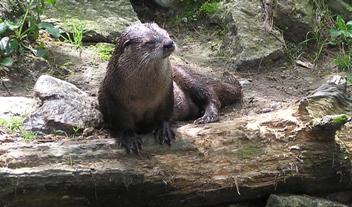
Photo from NH
Nature
Jed has seen a family of River Otters in
East Washington's Mill Pond! They come and go and spend time
fishing in the pond during the sumer and winter.
The River Otter is biggest of New Hampshire's weasels, at
25 to 40 inches long. These stately creatures of the water
are dark chocolate brown in color. River otters are sleek,
darkly furred and highly energetic creatures, appearing playful
as they slide from the shore into the water, dive and quickly
swim in search of their favorite food - fish. Fish and crayfish
make up the majority of their diet. Like other weasels, otters
are rarely seen, despite their abundance. They may roam as
much as nine square miles.
The sleek appearance of the otter belies the powerful muscles
under the relatively short-furred pelt. Its powerful head
muscles enable it to chew even turtles, and the power of its
limbs allows it to swim great distances under the ice of ponds
and streams in winter.
Female otters usually breed at age 2 or 3; their young are
born in April. Except for these family units, otters are generally
solitary animals. Although they are capable of living on their
own in 5 or 6 months, young otters usually stay with their
mother through the first winter and leave her just before
the next young are born. In New Hampshire, female otters give
birth to two or three offspring each year. They can live to
be 12 to 15 years old, although most survive only 5 or 6 years
in the wild.
Today, otters live in nearly all the rivers, streams, lakes
and ponds in New Hampshire. This has not always been the case.
Early historians described otters as being common throughout
the state, but unregulated trapping and hunting, pollution
of water and elimination of beaver - whose dams create otter
habitat - led to the near demise of the otter in the state
by the late 1800s. Their resurgence is do to cleaner waters
and the availability of habitat.
Stop by Mill Pond and see if you can spot the otters swimming,
fishing and having fun.
Most information from:
NH Fish and Wildlife
April:
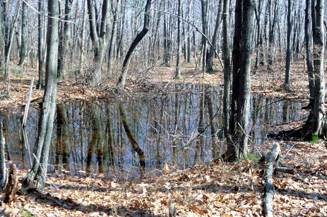
Photo from USDA
Forest Service
Vernal pools are wetlands with a seasonal
cycle of flooding and drying. Some vernal pools flood in the
spring with water from melting snow, rain or high groundwater
and then typically dry by summer’s end. Other pools follow
a similar pattern, but fill with rain in autumn, hold water
all winter and spring, and then dry out by late summer. The
annual drying cycle of vernal pools makes them different from
other wetlands and plays a key role in determining which wildlife
species uses which pools as habitat.
Vernal pools can exist almost anywhere—in forests, fields,
shrub swamps, marshes, or in gravel pits. They can be smaller
than one-tenth acre or larger than two acres. Vernal pools
occur as isolated wetlands (not connected to other wetlands),
as part of larger wetlands (for example, a vernal pool within
a scrub-shrub swamp), or in floodplains along rivers. Vernal
pools in woodlands are often small enough that the forested
canopy remains unbroken above them, staying shady and cool
throughout the growing season. These may be overlooked, appearing
as simple pools of water in the forest, with little vegetation
growing in them.
Fish are top predators in wetlands, but they can’t survive
in pools that dry out. As a result, vernal pools provide key
breeding habitat for amphibians whose tadpoles and larvae
are especially vulnerable to fish predation: wood frogs, spotted,
blue-spotted, and Jefferson’s salamanders. In the spring,
these amphibians migrate from nearby woodlands to vernal pools
where they breed and deposit their eggs. Once hatched, tadpoles
and larvae develop quickly into young frogs and salamanders
that must leave the wetland before it dries up by early
or mid-summer for wood frogs, or by late summer or early autumn
for salamanders.
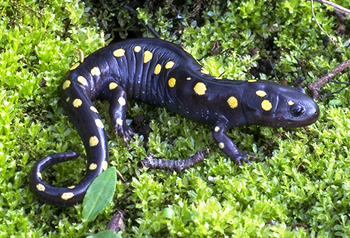
Spotted Salamander photo from
Vernalpool.org
Other species besides amphibians use vernal pools as habitat.
Fairy shrimp are small crustaceans that require vernal pools
for breeding. Spotted and Blanding’s turtles, great blue herons,
raccoons and predatory insects travel to vernal pools to feed
on amphibian eggs, tadpoles, insects and crustaceans in the
pools.
Many amphibians in New Hampshire migrate to their breeding
pools in the spring along discrete migration routes. Roads
may cut across these routes, and vehicle traffic can kill
migrating amphibians. Juvenile amphibians face similar threats
during their dispersal from the pools where they hatched.
So if you are driving on a wet spring night look carefully
for frogs and salamanders crossing the road and avoid them,
they are on their way to their vernal pool. Their lives depend
on you!
Information from:
NH Fish and Wildlife
If you joined us to visit the Vernal pool on Saturday
May 2nd you can now view the pictures! Click here:
Vernal Pool Pictures
March:

Photo from Washington
State Fish and Wildlife Department
You probably haven't seen one recently in
Washington but the true story is that Elk
(also known as Wapiti) used to roam here
in town. Elk are large deer relatives, second in size only
to the moose. They travel and feed in large herds. The bull
elk's bugling during breeding season can be heard for a very
long distance. Elk are not native to New Hampshire but they
lived here for a while...
In 1933, Austin Corbin III made a gift of elk, two bulls and
ten cows were released in Washington and Goshen into the Pillsbury
Reservation (which is now known as Pillsbury State Park).
At the time, it was a state game refuge. The elk flourished,
with their population growing to be between sixty and two
hundred. The animals began expanding their territory into
several surrounding towns, including Washington, Lempster,
Goshen, and Unity. Individuals and farmers who lost gardens,
orchards and crops to the voracious elk complained to state
and local government officials.
In 1941, the state decided to reduce the herd through its
first (and only) two-day elk hunting season. Two hundred hunters,
who had paid $5 for a special license, bagged forty-six elk
on December 17 and 18 of that year. Considering that the elk
were shot in herds, it is fortunate that no accidents were
reported. After the hunt, conservation officer Jesse Scott
estimated that only thirteen elk remained in the New Hampshire
woods.
In 1942, the first of a number of surveys was done, scouting
possible locations in Northern New Hampshire where the remaining
elk might be relocated to avoid their trespass into private
fields and orchards. These various proposals for relocating
the elk were ever acted on.
On March 16, 1955, conservation officers shot fourteen cows
and two bulls in Lempster. A few days later, an irate farmer
shot two bull elk. At this point, the Fish and Game Department
estimated that there were perhaps between twenty and thirty
free-ranging elk remaining in the state. It is commonly believed
that the remaining elk were killed by farmers or poached illegally
by hunters. No free-range elk have been spotted again in either
Washington or New Hampshire.
Information from:
Elk in Corbin Park and the wonderful book “Historical
Pillsbury” by Ron and Grace Jager, available through the Forest
Society.
February:

Photo from explorethebitterroot.com
A friend of Carol's found a large
moose "shed" recently. A shed is an antler that has
been dropped. Many people find that shed hunting is a great
cure for cabin fever! But, be prepared to compete with rodents
because sheds are rich in calcium, and mice and squirrels
gnaw them like candy. To find a pristine shed is very difficult.
Antlers consist of pure bone tissue and are shed and regrown
annually. This differs from horns which grow over the animal's
lifetime and are not shed.
Antlers grow by the accumulation of a cartilage-like bone
matrix . The development of antlers begins in the spring with
small nubs covered with "velvet," a layer of skin with oil
and scent glands and nerves, as well as the sparse coating
of hair that gives the velvet its name. Nutrients are supplied
from the animal's diet to the underlying bone and the antlers
grow quickly throughout the summer. The velvet stage begins
in spring and ends in the fall. Toward the end of the velvet
stage, growth slows and mineralization begins to increase
and the interior of the bone becomes more dense. The velvet
dies in the fall, and the animal rubs its antlers against
tree trunks and branches to get the dead velvet off.
Mating occurs later in the fall and in early winter when the
antlers are at their peak size and weight. Over a lifetime,
the subsequent antlers usually grow more branches, or "points,"
so that an individual's approximate age can be estimated based
on the number of points its antlers have.
In late December, day length begins to increase causing the
hormonal changes that ultimately lead bucks to drop their
antlers. As day length increases, it stimulates the pineal
gland to reduce testosterone production. As a result, the
bond between the skull and antler weakens, finally causing
the antlers to drop or shed. The bucks that participate most
actively in the rut usually shed first. After the antler is
dropped it is referred to as a "shed". Usually the antlers
are dropped separately, so it is hard to find a matching set.
The shed season can run from December through March. You should
search for sheds where bucks spend most of their time, near
food sources and bedding areas (in mid winter, deer will bed
as close to food as possible). Look up and down deer or moose
trails, steep banks, stream crossings and fence line edges.
Happy shed hunting!
January:
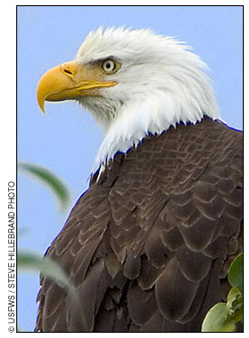
Photo from USFWS, Steve Hillebrand
Carol recently observed a Bald Eagle
eating from a small deer carcass on the ice of Halfmoon Pond.
They are listed as endangered in New Hampshire and threatened
in the United States but lately have been improving in this
state.
Bald eagles are at least 3 feet tall, with a wing span of
6-8 feet. Females can weigh as much as 14 pounds and males
weigh 7-10 pounds. The body and wings vary from dark brown
to black. At 4 years of age they acquire the white head and
tail. Their eyes are pale yellow and the powerful beak and
unfeathered feet are bright yellow.
In New Hampshire, one pair began nesting again in 1989 on
Lake Umbagog, after a 40-year absence. In 1998, another territorial
pair established a nest on Nubanusit Lake in Hancock. Bald
eagles are observed each winter in the Androscoggin, Connecticut
and Merrimack River Valleys, on Great Bay, and in the Lakes
Region. Non-breeding adults and immatures are observed sporadically
throughout the state year-round.
In this state, bald eagles occur in relatively undisturbed
forests along major rivers and lakes or near the coast. Eagles
perch on, hunt from, and nest on tall coniferous and deciduous
trees or snags near water. They prey primarily on fish and
waterfowl, but are also noted for their scavenging. In the
Northeast white pine are the most common nest trees, although
oak, ash, elm, maple, beech and hickory trees, snags, and
artificial platforms are used in some parts of their range.
In winter, they leave the breeding areas and congregate in
areas with large expanses of unfrozen, open water. A forest
stand that offers protection from inclement winter weather
is needed for communal night roosting. Night roosts are most
often found near foraging areas, but may be further away if
the roost is more protected.
Eagle-eyed observers saw a record-high total of 67 bald eagles
in New Hampshire during the 2008 National Mid-winter Bald
Eagle Survey two-week count period in January, including 59
(30 adults, 29 immatures) observed on Survey Day. The effort
was coordinated by New Hampshire Audubon in collaboration
with the New Hampshire Fish and Game Department's Nongame
and Endangered Wildlife Program.
If you see a bald eagle NH Fish and Game wants to know! If
you observe eagle breeding or roosting behavior, record the
time, date, where you observed the bird, what it was doing,
and a description of its feather coloration (plumage). Note
the direction of flight, if it flies away and any other significant
observations. Information may be sent to N.H. Fish and Game
Department, Nongame and Endangered Wildlife Program, 11 Hazen
Drive, Concord, NH 03301. Eagle observations can also be left
on a voice mailbox at (603) 224-9909 ext. 354.
All information and much
more can be found at
NH Fish and Game and at NH
Audubon and Eagle
count news
To view yearly archives of our "New In
Nature" series click on year you wish to see.
2002
2003
2004
2005
2006
2007
2008
2009
2010
2011
2012
|


